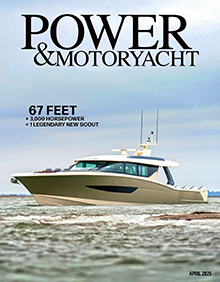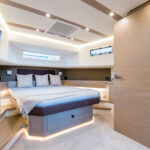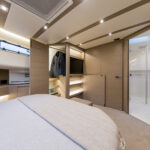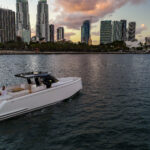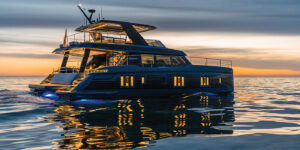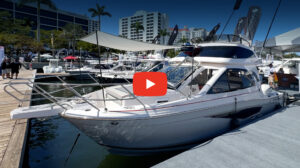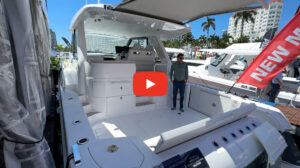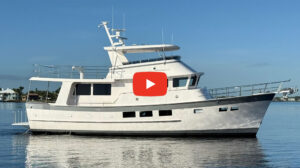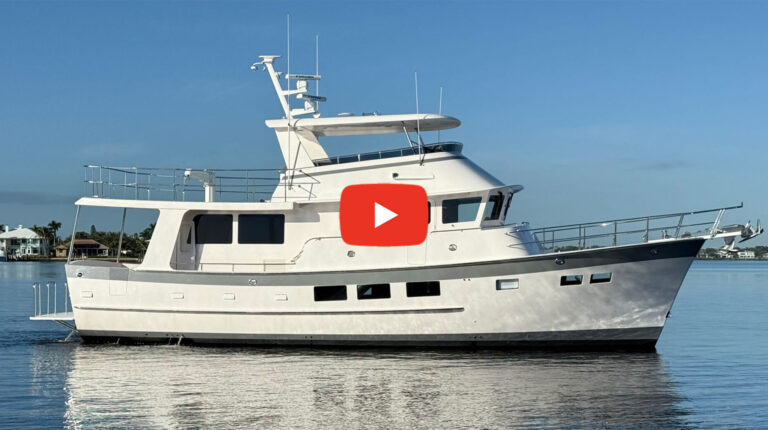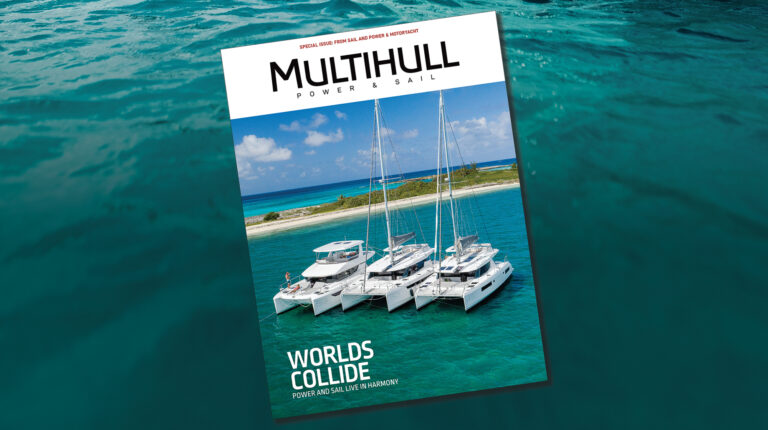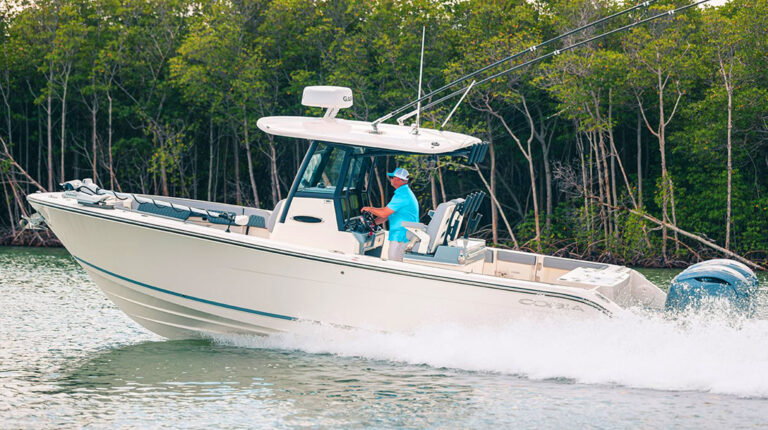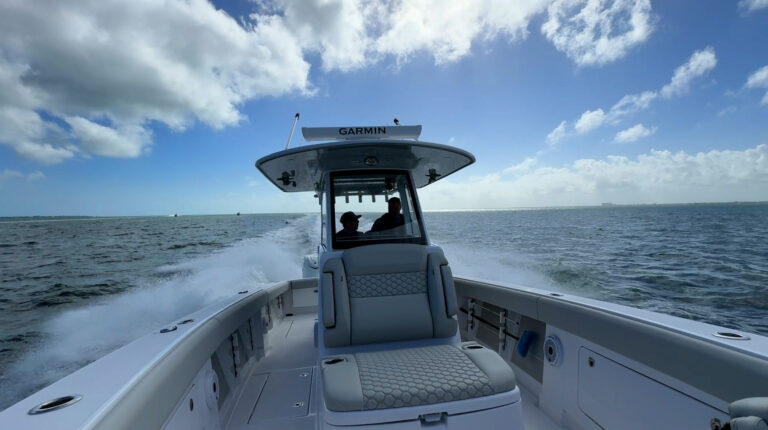Day Tripper
The new, Italian-built Pardo 50 redefines the express cruiser for the American marketplace.

If you’ve never heard the name Pardo before, don’t feel bad. The Italian motoryacht brand launched just three years ago with a 43-footer, following it up this year with the Pardo 50. But this is no Johnny-come-lately boat manufacturer—Cantiere del Pardo, based in Forlì, Italy, has serious yachtbuilding cred. Since 1973, the independent shipyard has manufactured the internationally renowned Gran Soleil racing and cruising sailing yachts, producing more than 4,500 hulls up to 80 feet in length.
Pardo is Gran Soleil’s lean, mean powerboat brother. Designed by Cantiere del Pardo in collaboration with Zuccheri Yacht Design, and featuring an aggressive reverse bow, edgy lines and wide-open cockpit, the Pardo 50 attracted a lot of attention during its U.S. boat show tour last winter. Although it was developed with the luxury express cruiser market in mind, the 50 takes the express cruiser concept and stands it on its head. For one thing, its profile is angular rather than sporting the traditional curves Americans are used to seeing on express yachts. Instead of having a multi-level cockpit, it has a flush, open deck that can hold 25 to 30 people. (We recommend doing this only at the dock.) And, while it has two staterooms and a hull designed for offshore performance, this yacht’s design brief is clearly more luxury day boat than long-range cruiser.
On a fine morning not long after the Pardo 50’s U.S. debut at the Miami Yacht Show, I sea trialed the yacht in the North Miami area. From my very first footfall onto a boarding step that deploys from the gunwale, I was impressed by the builder’s ability to combine practicality with elegance in true Italian fashion. Natural teak is standard for the coaming boards and deck. The large, optional hydraulic swim platform on our boat was also topped with teak, with wide—you guessed it—teak walkarounds that ran from transom to bow. In between was just about everything you need to enjoy a leisurely afternoon relaxing or entertaining on the water.
At the stern are three sunpads with headrests. Two more sunpads are located in the bow, along with a small settee and removable carbon fiber cocktail table. The foredeck can be sheltered via a sunshade that mounts on posts inserted into pre-set sockets.
In the main cockpit—the heart of the Pardo 50—is a generous, U-shaped settee with dining table. It is served by an outdoor galley, concealed in cabinets built into the carbon fiber hardtop supports. Galley equipment includes a grill, sink, refrigerator and optional icemaker; two freezer drawers pull out from either end of the settee. An electric shade extends from the hardtop to shield this area from the sun. It’s easy to envision owners and their guests hanging out in this cockpit from dawn to dusk, and beyond.
In case the owners should want to go for an overnight cruise, the Pardo 50’s belowdecks layout offers two staterooms and two heads. The headroom below is impressive—over 8 feet in the companionway and 6 feet, 2 inches in the master stateroom—something you would never guess when looking at the yacht from its exterior. Skylights contribute to an airy ambiance. The generous master stateroom with queen berth and en suite head with separate shower lies forward. The guest stateroom, which has twin berths (and lower headroom due to the cockpit overhead) has private access to the day head. The interior decor is minimalist but elegant, with leather accents incorporated into the furniture and cabinetry. Aft, there also is a separate crew’s quarters, accessed via a hatch from the deck, which is comprised of a bunk and wet head.

Don’t cruise with crew? Never sleep on board? No problem. Cantiere del Pardo is used to handling custom orders. “The clients very often have personalized requests,” said Rok Babarovic, Pardo business development manager. “On a recent sale, the owners wanted to do away with the staterooms and put a lower lounge and a big galley in the interior. We are quite flexible when it comes to changes.”
Likewise, the crew’s quarters could be used for a different purpose, such as accommodating an additional freezer or storage for water toys. But the yacht’s garage, which was designed to hold a Williams 285 (or a 9 foot, 6 inch RIB), can fit a few toys as well.
The engine compartment, which lies beneath the cockpit, has surprisingly high headroom: 5 feet, 7 inches at its entry. Then, you have to duck. Even so, access to the engines and equipment is easy and well thought out. The Pardo 50 that I sea trialed has upgraded engines—twin, 600-hp Volvo Penta IPS800s instead of the standard 435-hp 600s—and they still fit neatly in the space allotted. The boat also is equipped with a Cummins Onan generator and an air-cooled Quick MC2 X gyrostabilizer, and there is still plenty of elbow room to work in the engine compartment. Cantiere del Pardo’s fanatically neat wiring and electrical distribution panels are a testament to the 50’s nautical design heritage.
The helm once again combines functionality with sleek Italian design. Visibility is excellent through the large, single-piece tinted windshield. The large dashboard on our test boat held an integrated Garmin/Volvo Penta Glass Cockpit system with two 16-inch monitors in an easy-to-read, non-glare display, but the electronics package is up to the owner’s discretion. (It can be installed either in Italy or after arriving in the U.S.) The joystick control for the IPS drives system is located right next to the traditional controls. Danylo Koval, general manager of Pardo Yachts Miami, used the joystick to deftly ease us out of a tight slip at the start of our sea trial. “It’s cheating,” he said with a smile.

The Pardo 50’s hull, which is built of composite utilizing vinyl resin-infusion technology, with a high-density PVC sandwich in the hullsides, has an entry as sharp as its reverse bow advertises. The running surface starts with a 50-degree deep-V forward, gradually flattening out to a 16-degree deadrise at the transom. This variable-deadrise design lets the yacht slice through the waves while at the same time providing a dry, comfortable ride, which I experienced heading into the ocean via Miami’s Haulover Inlet on an outgoing tide. Even with a steep following sea, the bow tracked straight. “This is where most boats struggle,” Koval said. “The Pardo 50 has a new-generation hull.”
Out in the Atlantic, in calm seas, we opened up the throttles until the boat hit a top end of 35 knots. Backing down to an easy cruising speed of about 28 knots at 2600 rpm, I cranked the wheel into several hard turns; the driving experience, cushioned by the Pardo’s comfortable helm chair, was first-rate.

In November of last year, Cantiere del Pardo underwent a management buyout by longtime shipyard executives Fabio Panamente and Luigi Servidati, who acquired a majority share. They reported at the time that over the previous four years, the shipyard had registered an annual revenue of over 30 million Euros and they announced a capital increase of 5 million Euros. The investment is intended to help continue the growth and development of both the Grand Soleil and Pardo brands.
According to Babarovic, Cantiere del Pardo is now able to produce as many as 100 Pardo motoryachts per year. Delivery time for the Pardo 50 to the U.S. is approximately six months after you sign the contract; shorter, if you fly to Forlì, take delivery of the yacht at the shipyard and cruise the Med before shipping it home—a delightful option.
Hard on the heels of the Pardo 50’s introduction, the new Pardo 38 launched at the Yachting Festival de Cannes on the French Riviera in September. Designed with an entirely new hullform, the 38 is available with stern drives or outboards—including a triple installation.
If you’ve never heard of Pardo until now, don’t worry. This is a brand whose time in the limelight has only just begun.

Pardo 50 Layout Diagram

Pardo 50 Test Report

Pardo 50 Specifications:
LOA (w/plat.): 53′
Beam: 16′
Draft: 4′
Displ.: 32,849 lbs.
Fuel: 520 gal.
Water: 132 gal.
Power (as tested): 2/600-hp Volvo IPS800

